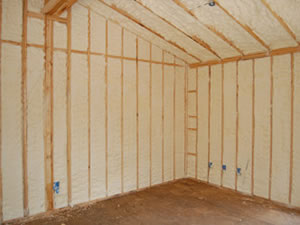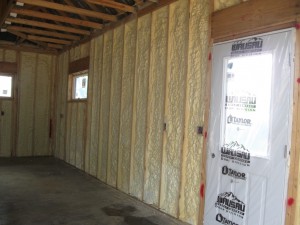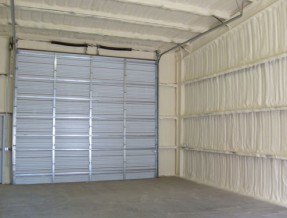Effective Wall Insulation
Properly sealed, moisture-protected, and insulated walls help increase comfort, reduce noise, and save on energy costs. However, walls are the most complex component of the building envelope to insulate, air seal, and control moisture.
The keys to an effective wall are:
- Airtight constructional air leaks sealed in the wall during construction and prior to insulation installation.
- Moisture / rain drainage system, continuous air barrier, and vapor barrier located on the appropriate side of the wall.
- Complete insulation coverage
- Advanced framing to maximize insulation coverage and reduce thermal bridging, no gaps or compressed insulation, and continuous insulated sheathing.
Residential Wall Insulation:
 Little Product… BIG Benefits!
Little Product… BIG Benefits!
Spray Polyurethane Foam (SPF) insulation is rigid, lightweight, flexible, wind resistant, and effective in extreme temperatures and weather conditions. SPF insulation has the highest R-value per square inch of any commercially available insulation material.
Total Comfort Control, Not Just R-Value
The building envelope is a system of construction components which protect against the uncontrolled movement of: heat, air, and moisture. The true performance of your building envelope can not be measured with the R-value of the insulation alone, but must also consider air movement, moisture control, health, safety, durability, comfort, and energy efficiency.
This is true whether your building is commercial, residential, or multifamily: SPF addresses all these needs in both new construction and improvements to existing structures. Six Mechanisms of Heat Loss Through a Wall or Ceiling That Are Bad for Your Home and Your Health:
- Conduction
- Radiation
- Convection Currents
- Infiltration (Wind Pressure)
- Intrusion (Wind Wash)
- Moisture Accumulation (Humidity, Dew, and Frost)
 Did you know?
Did you know?
- Air infiltration can increase energy costs in buildings 10 to 40%.
- SPF reduces air infiltration allowing insulation to be more effective and reducing the demands on HVAC equipment.
- SPF reduces moisture infiltration by reducing air leakage.
- SPF adds structural strength to walls and ceilings.
- SPF reduces sound transfer into buildings. Most sound from outside the building is carried into the building through cracks and air leaks. SPF by stopping the air infiltration also helps keep sound out.
- SPF minimizes dew point problems and condensation.
- SPF resists heat transfers through air infiltration regardless of flow direction.
- SPF provides reliable R-values under the most extreme conditions, dependable and durable protection against heat loss or gain.
- SPF minimizes thermal bridging, which can cause higher energy usage and cost.
- SPF out-performs conventional insulation materials because they trap still dry air and if that air moves or becomes wet, the thermal resistance can drop by 50%.
- According to ASHRAE, a 3% void area in a wall cavity represents a 15% reduction in wall R-value.
Commercial Wall Insulation
 Spray foam insulation could be the best insulation system yet invented. Look at the following advantages:
Spray foam insulation could be the best insulation system yet invented. Look at the following advantages:
- On the inside of the wall panel of a building it has an extremely high R value, it has been shown to dramatically increase the racking strength in steel and timber frame buildings, in some instances has been specified to prevent wind uplift in commercial roofing systems.
- On the outside of the building it can be used as a combined vapor and air barrier system and is recognized as such when applied to the American Air Barrier Association standards. It can also be used below grade for the insulation of basements and foundation.
- It does not emit VOCs or hydrocarbons and has a proven track record over the last 20 years.
Air Sealing
Air sealing reduces heat flow from air movement (convection) and prevents water vapor in the air from entering the wall. In a 100-square-foot wall, one cup of water can diffuse through drywall without a vapor barrier in a year, but 50 cups can enter through a 1-inch, round hole. In fact, sealing air leaks is 10 to 100 times as important as installing a vapor barrier.
Closed Cell Wall Polyurethane Wall Foam
Closed cell polyurethane wall foam provides an insulation value of 6.7-7 per inch and provides an air barrier at an application thickness of 1 in. Here are some of the additional benefits provided by closed cell wall foam:
- It can prevent moisture infiltration from air leakage
- Minimizes air flow within the wall
- Helps eliminate drafts
- Seals cracks and openings in wall
- Will not settle or sag
- Adds structural strength to the wall
- Provides a layer of seamless insulation
- Fully adheres to the surface it is applied to
- Does not contain any dangerous chemicals that can gas off
- Lightweight, does not add weight to walls or roof assemblies
- Approved for use by most building and fire codes
Open Cell Wall Polyurethane Wall Foam
Open cell polyurethane wall foam provides an insulation value of 3.5 per inch. Here are some of the additional benefits provided by open cell wall foam:
- Can prevent air leakage
- Minimizes air flow within the wall
- Helps eliminate drafts
- Can provide some sound attenuation
- Seals cracks and openings in wall
- Will not settle or sag
- Provides a layer of seamless insulation
- Fully adheres to the surface it is applied to
- Does not contain any dangerous chemicals that can gas off
- Lightweight, does not add weight to walls or roof assemblies
- Approved for use by most building and fire codes

